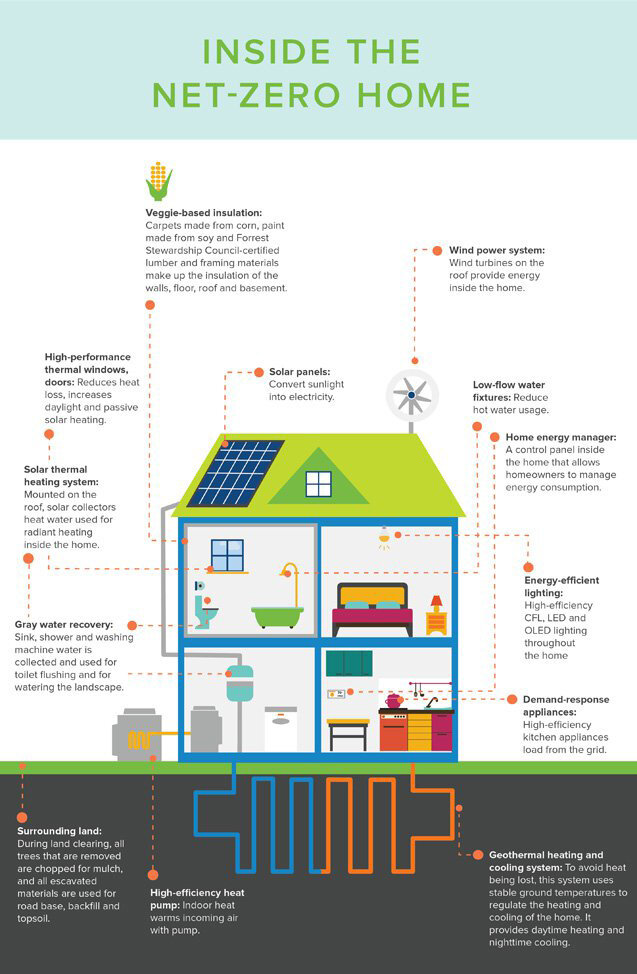Creating a Net Zero Home
Net zero homes produce as much energy as they use. A net zero home is not only great for the environment, but your wallet and health as well. While net zero is a method unto itself, similar programs that work towards reducing energy use and leakage in a home include Passive House, Energy Star, National Green Building Standards, and LEED for homes.
Getting to net zero in your home can take many paths. Not every home will achieve net zero in the same way since there are so many methods to reduce energy consumption and eliminate leakage from your home. Some components include:
Insulating exterior walls. There are a number of options to adding insulation from blow in to opening up walls for batt insulation. Increasing the insulation will decrease the amount of energy lost through your walls.
High-performance thermal windows and doors. This will reduce heat loss as well as electricity use by capturing daylight and passive solar heating. If you have original wood windows however, it is less sustainable to replace them with new thermal windows because a properly restored wood window with new thermal panes will last far longer than a replacement window.
Solar panels. Residential solar systems have become increasingly common as costs have gone down on installation. Depending on the amount of panels installed and the amount of sunlight available, they can reduce energy bills significantly.
Solar thermal heating system. These types of systems are typically mounted on the roof and are used to heat water for radiant heating or power your water heater using solar energy.
Gray water recovery. These systems can run into hurdles with installation in communities that have not adopted building codes that supporter water recovery. These systems use sink, shower, and washing machine water to flush toilets and water the landscape, greatly reducing the amount of water you purchase each month for these daily tasks.
Low-flow water fixtures. One of the easiest changes to make to your home is installing low-flow water fixtures which reduce the amount of water used in showers, sinks, and toilets.
Home energy management system. One way to track the energy used in your house is installing a home energy management system which allows you to manage your energy consumption. You can view which devices are using the most energy, what time of day energy use is at its peak, and see trends in the data.
Energy efficient lighting. Another really easy change is installing high-efficiency LED lighting in your home. Most LED lights operate at lower voltages and convert about 70% of their energy in light and therefore use less energy than their incandescent counterparts.
Efficient appliances. An efficient dishwasher saves more water than handwashing and an efficient dryer will take less time to dry a load of laundry, reducing the amount of energy consumed.
Geothermal heating and cooling. While previously reserved for large scale projects like an elementary school renovation, geothermal heating and cooling is becoming more common in residential applications. The system uses the stable ground temperatures to regulate the heating and cooling of the home as it passes water through pipes drilled deep into the ground.
High efficiency heat pump. Heat pumps are an efficient way to heat a home. They beat out gas heat with efficiency at between 450 and 500% greater. A heat pump transfers heat from a cool space to a warm space and does not actually generate heat.
While its possible to make many of these changes, involving an expert can be helpful if you are attempting a whole home retrofit or new build. It can be a challenge to find a professional in your area experienced in net zero home designs or retrofits, but there are a few ways to search that may aid in finding the right person for the project. According to EcoHome, try searching for builders, draftsperson, or architects with certification or experience in Passive House or LEED. Even if you are not interested in meeting these standards, if they are experienced in these programs, they will know how to achieve your net zero energy goals. You can also try searching terms such as green or sustainable builder. Using this technique I came up with Authenticity LLC, a firm with experience in Net Zero Homes in Nebraska.
When you narrow down the list of designers/builders make sure to ask about their experience with building high-performance or energy efficient homes, insulating exteriors, energy efficient components, and whether they do energy modeling.
While it may seem intimidating to achieve a true net zero home, committing to making a few changes mentioned above is a good start towards energy and cost savings. You may not be ready for solar panels on your roof, but replacing your appliances and lighting with energy efficient models will go along way to reducing the amount of energy your home uses. And reducing energy consumption will have a positive impact on your wallet, the electric grid, and the environment.






